5 Ginseng Look-alikes
Do you want to know if there are any ginseng look-alikes out there? Here is a list of plants that can easily be misidentified as ginseng.
Not many people know the value of ginseng, but it has been prized in traditional Chinese medicine for centuries and was even a vital trading commodity in colonial America due to its rarity and reputation as an aphrodisiac.
Various parts of ginseng plants are utilized in the making of medicinal teas, tinctures, powders, and capsules. These include berries, leaves, and roots.
The ginseng plant contains active compounds called “ginsenosides” which are known to possess numerous pharmacological properties including immunostimulatory, antiatherosclerotic, anticarcinogenic, and antihypertensive effects. (source)
It’s also one of the few medicinal plants that can still be harvested sustainably, though you’ll need to know what to look for if you want to harvest it on your own land or hunt it down in the wild. Therefore, this article focuses on some other plants with a similar appearance to help aid in identification.
Contents
The Uniqueness of Ginseng Plants
Ginseng plants are perennial herbaceous plants with woody roots. They grow in the temperate regions of East Asia, southeastern Canada, and Central America.
The genus Panax includes both Asian and Central American ginseng. It is believed that they may have originated in northeastern China or southeastern Siberia and then spread across eastern Asia as humans cultivated them.
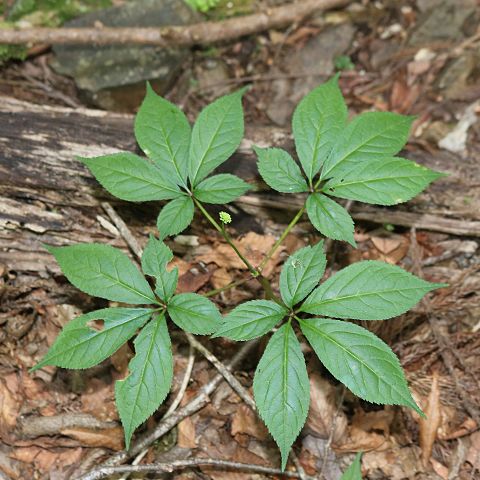
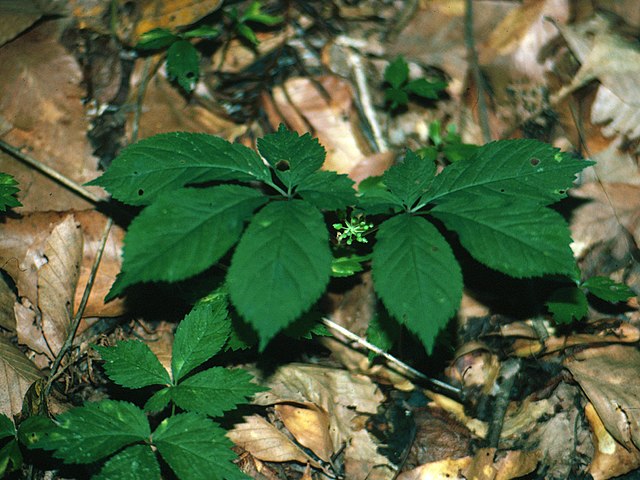
With palmately compound leaves, the ginseng plant is easily identified from other species by its unique leaf shape. There are 3–5 leaflets per leaf, and they can grow 8 to 15 inches tall.
One characteristic of ginseng plants is the white sap found near leaf nodes. A mature root can reach 3 to 4 inches long and 1-inch wide, though it varies depending on soil quality and the growing environment.
Last but not least, ginseng plants take at least 5–7 years before they are ready for harvest. When you decide to harvest your ginseng plant, make sure you do so from September 1 to November 30th. Harvesting too late will result in less potency while harvesting too early could damage the roots.
You have to be careful when picking wild ginseng because there are several species of plants that resemble it and some can even be poisonous, such as poison ivy.
Let’s see several plants that can be easily confused with ginseng.
Ginseng Look-alikes
1. Virginia Creeper (Parthenocissus quinquefolia)
Virginia creeper (Parthenocissus quinquefolia) is a woody and deciduous vine commonly found in Mexico, central, eastern, and south America.
The leaves are long (6 inches), ovate with toothed margins, and have 5 leaflets. The flowers are greenish-white, small, and mostly appear in springs. It can also be found in shady woods or moist soils at low elevations in mountainous regions.
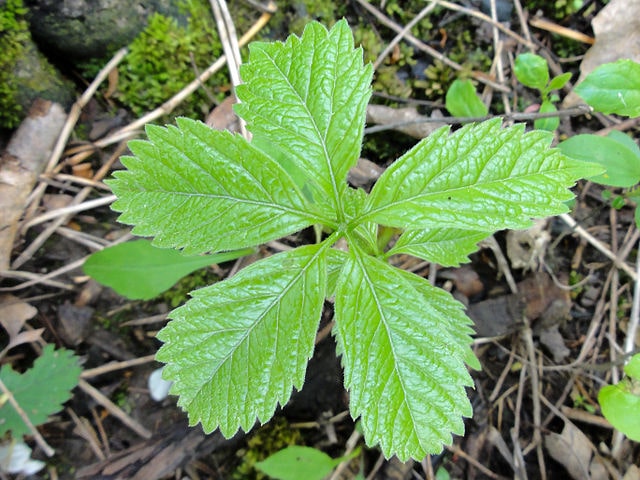
The fruit resembles grapes that turn purple when ripe and black when dried. They can be eaten raw or cooked but have an extremely sour taste.
It has been used as a folk remedy for diarrhea, constipation, and dysentery. What makes Virginia creeper and ginseng look alike? Both plants have leaves that are on vines that grow in shady forests. And like ginseng, Virginia creeper fruits resemble grapes and go from green to purple when they ripen, then black when dried.
2. Wild Sarsaparilla (Aralia Nudicaulis)
This wildflower is common throughout much of North America east of the Rocky Mountains, where it is often seen along roadsides and in open woods.
A member of the spikenard family, this plant bears shiny, three-lobed leaves reminiscent of a cloverleaf — its scientific name comes from this resemblance.
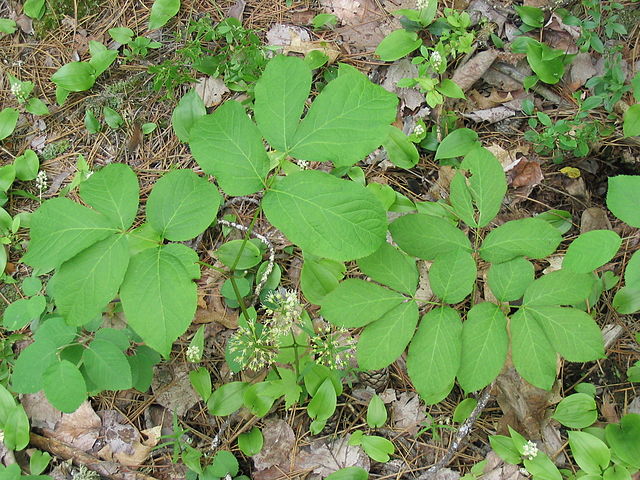
In late summer, it grows spikes of tiny white flowers in dense clusters atop slender stalks; these produce red berries that last through winter.
The roots are medicinal, containing compounds called saponins and alkaloids. These act against bacterial infections and parasites, making wild sarsaparilla a favorite Native American herbal remedy for many ailments, including skin problems like eczema.
This plant compares to ginseng because both contain saponins and alkaloids and grow alongside each other.
3. Thicket Creeper (Parthenocissus Inserta)
Parthenocissus inserta, or the thicket creeper, is a species of flowering plant in the grape family.
This wild ginseng look-alike’s leaves are distinguished by their oblong-shaped and texture that is rough on the upper surface and has hairs on the underside.
Like other members of its genus, it can be found in North America, southeastern Canada, and other parts of the United States.
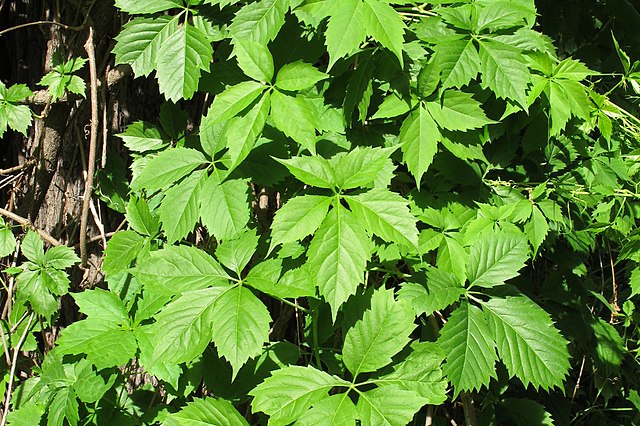
This plant is a sprawling and climbing vine that resembles the shape of a Virginia creeper (Parthenocissus quinquefolia). However, this vine grows thicker stems than Virginia creeper vines. It will climb up trees to a height of 6-8 meters in some cases.
These plants are mistaken for ginseng when they are young because they grow opposite one another at the base of the leaf stalk; however, unlike true ginseng roots, which always form small tubers near the soil line, thicket creeper roots grow close to the vine itself.
4. Buckeye (Young Plants)
They are a variety of redbud that can be found in the eastern United States. They grow in clumps and will produce clusters of white flowers during the spring and summer months. The leaves of this plant are a shiny, dark green color which helps distinguish it from other plants with similar flower shapes.
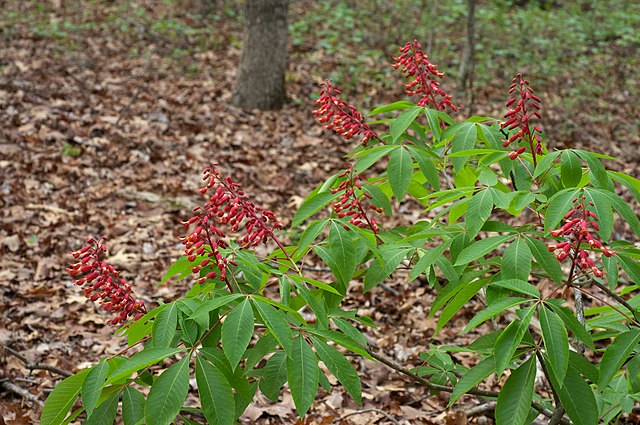
The fruit of this plant is edible but sour and not at all sweet like ginseng berries. However, if you’re still interested in foraging for this plant, you’ll know it when you see its fruit pods, as they have an elongated shape to them and are usually hanging off branches or dangling close to the ground.
Another thing you’ll distinguish Buckeye young plants from ginseng because Buckeye has rigid and woody stem structures, whereas ginseng plant stems are more pliable.
5. Shagbark Hickory (Young Plants)
Shagbark hickory young plants are one of the most common ginseng look-alikes. The scientific name for the shagbark hickory is Carya ovata.
When young, Shagbark hickory portrays some physical similarities to American ginseng in that it has the same leaf shape and color. When cut, they may also have a white sap that mimics the clear sap from an American ginseng plant.

They also have 5 leaflets, like many other deciduous trees, making them difficult to distinguish without further inspection.
It should be noted, however, that the leaves of Shagbark hickory tend to be a lighter green than American ginseng; its stems are reddish brown or light brown, whereas American ginseng’s stems remain green even when mature.
They grow quickly and can reach a height of 60-80 feet tall. Their fruit (shagbark nuts) have a cream or gray color and are edible but not as nutritious as American ginseng roots.
Final Word
In essence, ginseng plants play an essential role in the medicinal realm. It is used for its anti-inflammatory and antioxidant effects, which may be helpful to those with asthma or other breathing difficulties.
The plant is also known to boost immune system function, relieve heartburn, lower blood sugar levels and even improve memory. Others use it to enhance their brain function and mental clarity by taking ginseng extract, but this isn’t recommended if you’re pregnant or breastfeeding. It is also not recommended for children because there haven’t been enough studies to show that it is safe.
Also, be aware of ginseng’s possible side effects, like insomnia or headaches, so you know what to expect and can treat them accordingly.
Overall, the ginseng plant is a valuable plant that deserves respect when found. When searching for this medicinal plant, it is essential to be careful not to confuse it with one of its look-alikes such as the ones mentioned above.
We also have created a useful list of phone apps that you can use to identify ginseng and other plants by simply taking a photo of their leaves, flowers, or fruits.
This article has only an informative purpose and does not offer medical advice in any way. Always talk to your doctor before using ginseng as a health supplement.

